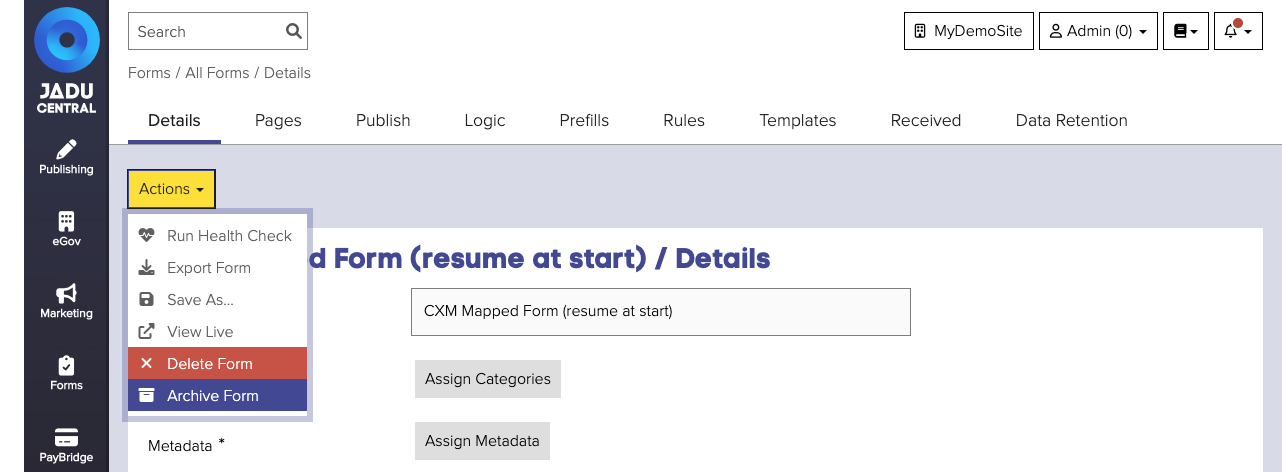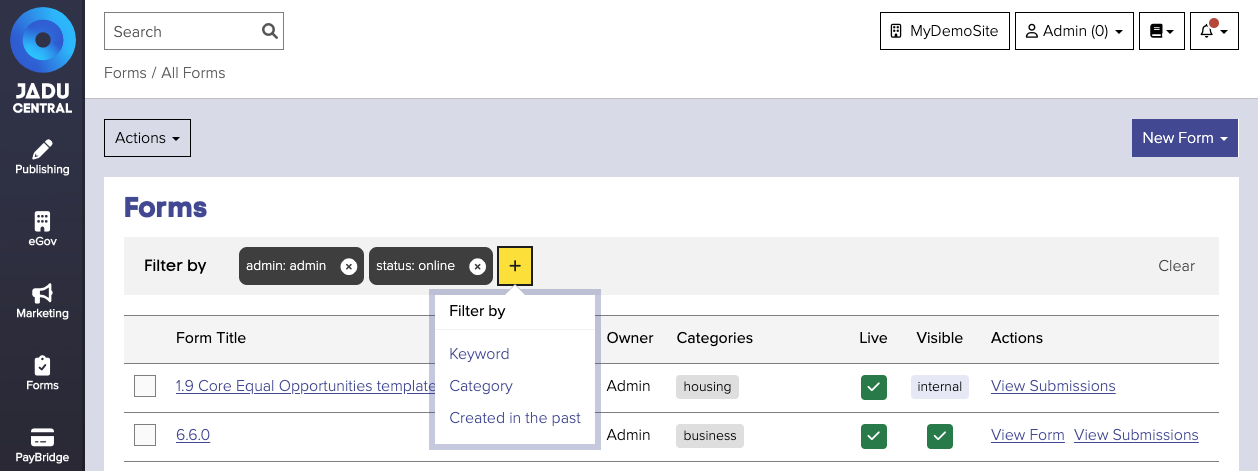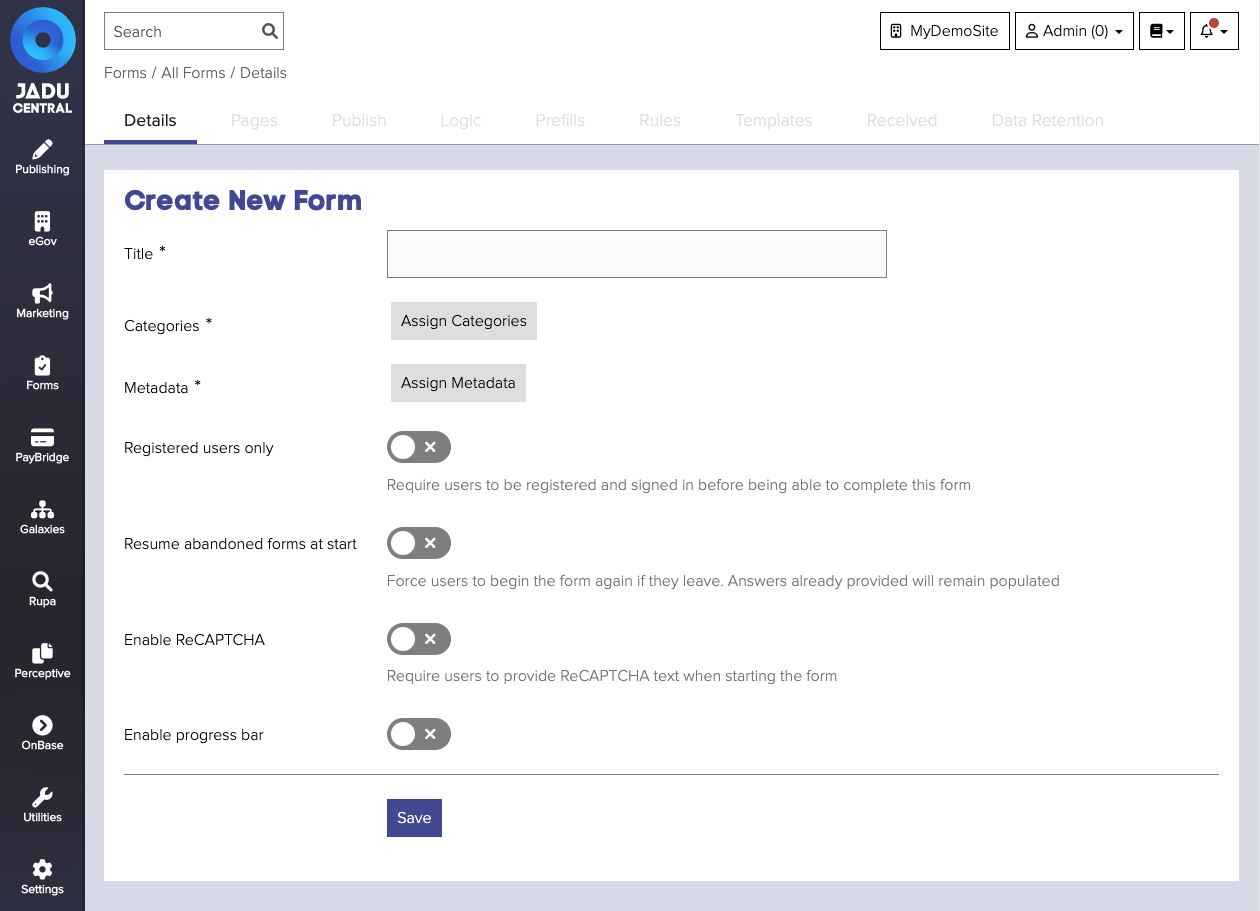Forms
Managing forms
Forms are managed via the Forms menu.
If your account has permission to access forms, you navigate to their management area by the following:
- Click the Forms icon in the left navigation bar. The Forms menu will open.
- Click the Forms link in the first group of links. A list of forms will now be shown, with links to create new forms if your account has the appropriate access permissions.
When you create a new form, you may see options for different versions of the form builders, if you do choose Use New Form Builder (recommended).
Changing form settings
- Navigate to the form management area, and open the form you wish to edit.
- Click the Details tab to open the form settings form.
- Update the required values, and click the Save button to save your changes.
Publishing a form
Once your form is setup you'll want to publish it on the website.
- Navigate to the form management area, and open the form you wish to edit.
- Click the Publish tab to open the publishing options. Further information is available in the Publishing section.
- To make your form live click the toggle next to 'Live', the toggle will go green when it's enabled.
Once your form is live, the View live option will now be available. Test your form by clicking the 'View live' link which will open the form up in a new window.
Form URLs
- To retrieve a link to a published form use the View live option from the Publishing tab.
Form URLs without previously unsubmitted data included
To access a form without any previously unsubmitted data included within the form answers:
- Add
/startto the form URL. For example, example.com/xfp/form/1/start - Within the Control Center add
userFormID=-1to the form URL.
Duplicating a form
To create a copy of a particular form:
- Navigate to the form management area, and open the form you wish to duplicate.
- Click the Details tab to open up the form details.
- Click the Actions menu, and select Save As from the options presented. The Copy Data interface will open
- Specify the title of the copied form and click the Continue button. A copy of the form will now be created.
Archiving a form

Archiving a form is a good way of stopping access to a form without deleting any submission data attached to it. If a form is archived, it cannot be completed on the website or via internal forms, but historical submissions will still exist.
To archive a form:
- Navigate to the form management area, and open the form you wish to archive.
- Click the Details tab to open up the form details.
- Click the Actions menu, and select Archive Form from the options presented. A panel will open asking you to confirm the action.
- Confirm the action by clicking the Archive button.
Deleting a form
This will delete the form irretrievably, and also destroy all customer submissions to it.
To delete a form:
- Navigate to the form management area, and open the form you wish to delete.
- Click the Details tab to open up the form details.
- Click the Actions menu, and select Delete Form from the options presented. A panel will open asking you to confirm the action.
- Confirm the action by clicking the Delete button.
Filtering the form list
The forms list view is the place where the forms in your system are accessed. A form can be in three states; Online, Offline and Archived. It is possible to see forms in each state by filtering the list view by status.
The forms list view has a filter bar, which can be used to restrict the forms shown in order to make finding a certain form easier. The following filters are available:
- Admin: the name of administrator who owns the form
- Status: Online, Offline or Archived
- Keyword: Allows searching for a word relevant to the form, e.g. a word in the title
- Created in the past: a way of finding newly created forms
- Category: show only forms in a certain category
Adding a filter

- On the forms list view, click the + button next to Filter by at the top of the list view.
- Choose a filter option from the list that appears and set the value of the filter.
- Click the Add button and then click the Filter button.
- The forms list view will refresh, and is now filtered to forms matching the applied filter.
Note that, if you do not see Keyword, there is already an Keyword filter applied to the list. This must be removed by a new one can be added.
Removing a filter
To remove a filter, click the x on the corresponding black label at the top of the list view.
To remove all filters, click Clear.
Form fields

| Field | Notes | Required? |
|---|---|---|
| Title | Create a relevant title as this title will be used to reference your form when someone searches for it within your application. | ✅ |
| Categories | Location of this form in your site's navigation structure. See Categories for further details. | ✅ |
| Metadata | Hidden information about this form. See Metadata for further details. | ✅ |
| Registered users only | Restrict access to your form to only site visitors that are registered and signed into the website. By default any site visitor signed in or not can access and complete a form created in Jadu Central. | |
| Resume abandoned forms at start | If a site visitor abandons the form part way through they can come back to it again. A site visitor's incomplete forms are accessible from the my account area on the website. This is commonly referred to a save and return. By default the site visitor will resume on the last page they completed. If your form has some branching logic based on an external source, or if your form allows the site visitor to make a booking, it would be preferable for the customer to return to the beginning of the form. | |
| Enable ReCAPTCHA | To separate humans from spam bots you can enable ReCAPTCHA before submission on your forms. This will require the site visitor to prove they are human by answering a reCAPTCHA before they can submit the their form. | |
| Enable progress bar | A progress bar provides feedback to your site visitor on how many pages in the form they have completed and still have left to complete. When enabled the progress bar will be displayed at the top of the form page. |
For linear forms (forms that don't have any page level branching) progress is reported as page x of y . If the form has page level branching progress is reported as page x of y (possible) until the point where the site visitor has progressed far enough into the form and it is known how many pages they will visit.